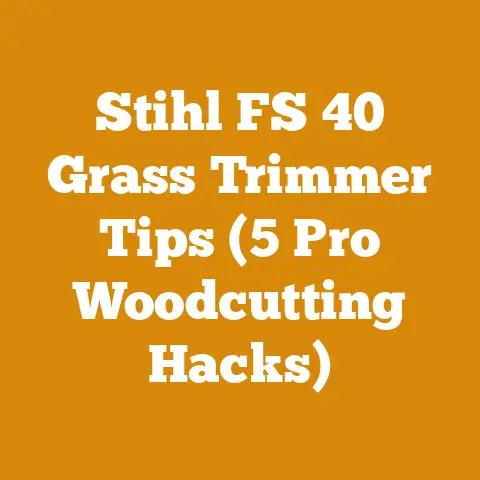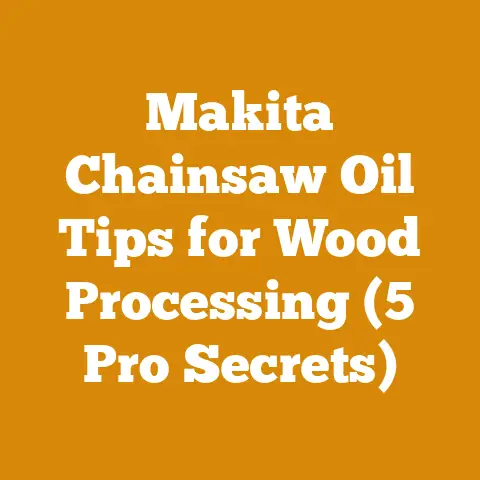Harness for Cherry Picker Safety (5 Arborist Tips You Need)
So you’re looking to elevate your arborist game, literally and figuratively, with a cherry picker? Smart move! But before you go soaring among the treetops, let’s talk about something crucial: safety harnesses. I’ve spent years wrestling with timber, both on the ground and perched high above it all, and I can tell you firsthand that a proper harness isn’t just a piece of equipment; it’s your lifeline.
I’m going to walk you through the essential arborist tips you need to know about using a harness safely in a cherry picker. We’ll cover everything from choosing the right harness to inspecting it properly, connecting it securely, and understanding the crucial role of fall protection. Let’s dive in and keep you safe up there!
The State of Play: Arboriculture and Safety in Numbers
Before we get started, let’s talk about the big picture. Arboriculture, while rewarding, is inherently risky. Globally, the logging and tree care industries consistently rank among the most dangerous occupations. According to the International Society of Arboriculture (ISA), falls are a leading cause of serious injuries and fatalities in tree work. Data from the Occupational Safety and Health Administration (OSHA) in the United States shows that inadequate fall protection is a recurring violation during tree care operations.
What’s more, the demand for skilled arborists is increasing, driven by urbanization, climate change impacts on tree health, and a growing awareness of the importance of urban forests. This translates to more people entering the field, many of whom may lack the necessary experience and training in safety procedures. That’s why understanding and implementing proper fall protection measures, including the correct use of harnesses, is more critical than ever.
Why This Matters: A Personal Anecdote
I remember one sweltering summer day, working on a massive oak tree removal. I was about 30 feet up in the bucket of the cherry picker, feeling confident and maybe a little too comfortable. I’d been using the same harness for years, hadn’t inspected it as thoroughly as I should have, and was rushing to finish the job before a storm rolled in. Suddenly, a branch I was cutting shifted unexpectedly, throwing me off balance. For a split second, I felt that sickening lurch of falling. Thankfully, my harness held, and I was left dangling, shaken but unharmed. That near-miss was a wake-up call. From that day on, I vowed to never take fall protection for granted and to always prioritize safety above speed. That experience is why I’m so passionate about sharing this information with you.
Understanding the Basics: Harnesses and Cherry Pickers
Let’s break down the core components of our safety equation: harnesses and cherry pickers.
What is a Cherry Picker (Aerial Lift)?
A cherry picker, also known as an aerial lift or boom lift, is a mechanical device used to provide temporary access for people or equipment to inaccessible areas, usually at height. In arboriculture, they are invaluable for pruning, removing trees, and performing inspections.
What is a Fall Arrest Harness?
A fall arrest harness, sometimes called a full-body harness, is a piece of equipment designed to distribute fall forces safely across the body, minimizing the risk of injury. It’s essential for anyone working at height, including in a cherry picker.
Key Differences Between Full Body Harnesses
- D-Rings: The location and number of D-rings on a harness dictate its intended use. A dorsal (back) D-ring is standard for fall arrest. Some harnesses have side D-rings for positioning or restraint. Front D-rings are often used for rescue or controlled descent.
- Adjustability: A well-fitting harness is crucial. Look for harnesses with multiple adjustment points (legs, chest, shoulders) to ensure a snug and secure fit.
- Padding: Padding on the shoulder straps, back, and leg straps can significantly improve comfort, especially during long workdays.
- Material: Harnesses are typically made from nylon or polyester webbing. Consider the durability and resistance to abrasion of the material.
- Weight Capacity: Always check the weight capacity of the harness to ensure it is appropriate for your body weight and the weight of any tools you are carrying.
5 Arborist Tips for Harness Safety in a Cherry Picker
Now that we’ve laid the groundwork, let’s get into the practical advice. Here are five essential arborist tips for using a harness safely in a cherry picker:
1. Choosing the Right Harness: Fit, Function, and Features
The first step is selecting the right harness for the job. Not all harnesses are created equal. Here’s what to consider:
- Fit: A properly fitted harness is paramount. It should be snug but not too tight, allowing for a full range of motion without slipping or shifting. Imagine trying on a new pair of boots – you wouldn’t buy a size too big, would you? Same principle applies here.
- Sizing: Most manufacturers provide sizing charts based on chest and waist measurements. Use these charts as a starting point, but always try on the harness if possible.
- Adjustment: Adjust the leg straps, chest strap, and shoulder straps until the harness fits snugly. You should be able to slide two fingers between the straps and your body.
- Positioning: The dorsal D-ring should be positioned between your shoulder blades. If it’s too high or too low, adjust the shoulder straps.
- Function: Consider the specific tasks you’ll be performing in the cherry picker.
- Fall Arrest: A harness with a dorsal D-ring is essential for fall arrest.
- Positioning: If you need to be positioned in a specific location, such as for pruning, a harness with side D-rings can be helpful. These rings allow you to attach a positioning lanyard, which helps you maintain your position and free up your hands.
- Suspension Trauma: Look for a harness with suspension trauma straps. These straps allow you to relieve pressure on your legs and improve blood flow if you are suspended in the harness after a fall.
- Features:
- Padding: Padded shoulder straps and leg straps can significantly improve comfort, especially during long workdays.
- Tool Loops: Tool loops are handy for carrying small tools and equipment. Make sure the loops are strong enough to support the weight of the tools.
- Reflective Material: Reflective material can improve visibility, especially in low-light conditions.
Example: I once worked with an arborist who insisted on using an oversized harness because he thought it was more comfortable. During a routine branch removal, he leaned too far over the edge of the bucket, and the loose harness shifted, causing him to lose his balance. He was lucky to avoid a fall, but it highlighted the importance of a properly fitted harness.
2. Pre-Use Inspection: Your Daily Safety Ritual
Before every single use, meticulously inspect your harness. This isn’t just a formality; it’s a critical step in ensuring your safety. Think of it like checking the oil in your chainsaw before firing it up – you wouldn’t skip that, would you?
- Webbing: Look for cuts, tears, abrasions, burns, or chemical damage. Pay close attention to areas around D-rings and buckles, as these are points of high stress.
- Stitching: Check for broken or loose stitches. Stitching is what holds the harness together, so any damage here is a red flag.
- D-Rings: Inspect D-rings for cracks, bends, corrosion, or distortion. Make sure they move freely and lock securely.
- Buckles: Check buckles for damage, corrosion, or distortion. Make sure they latch securely and release smoothly.
- Labels: Ensure all labels are present and legible. These labels contain important information about the harness, including its model number, manufacturing date, and weight capacity.
Data Point: Studies have shown that a significant percentage of harness failures are due to pre-existing damage that was not detected during pre-use inspections. A thorough inspection can significantly reduce the risk of accidents.
Actionable Tip: Develop a checklist for your pre-use inspections. This will help you ensure that you don’t miss any important details.
Troubleshooting: If you find any damage during your inspection, do not use the harness. Tag it out of service and replace it immediately. It’s better to be safe than sorry.
3. Connecting Your Lanyard: Secure the Link
Connecting your lanyard to the harness and the anchor point in the cherry picker is the final link in your fall protection system. Here’s how to do it right:
- Anchor Point: Identify the designated anchor point in the cherry picker. This is typically a reinforced D-ring or other attachment point specifically designed to withstand fall forces.
- Lanyard Type: Use a lanyard that is appropriate for the task. Common types include:
- Fixed-Length Lanyards: These lanyards have a fixed length and are typically used for fall arrest.
- Adjustable Lanyards: These lanyards can be adjusted to different lengths, allowing you to maintain a safe working distance from the edge of the bucket.
- Self-Retracting Lifelines (SRLs): SRLs are similar to seatbelts. They allow you to move freely within the bucket while providing immediate fall protection.
- Connection: Connect the lanyard to the dorsal D-ring of your harness. Ensure the connector is fully engaged and locked.
- Slack: Minimize slack in the lanyard. The less slack, the shorter the fall distance.
Real Example: I once witnessed a near-miss when an arborist connected his lanyard to a railing in the cherry picker instead of the designated anchor point. The railing was not designed to withstand fall forces and likely would have failed in the event of a fall.
Strategic Recommendation: Always double-check your connection before starting work. It only takes a few seconds, and it could save your life.
4. Understanding Fall Distances: The Physics of Falling
Understanding fall distances is crucial for selecting the right lanyard and ensuring that you have adequate clearance below the cherry picker.
- Free Fall Distance: This is the distance you fall before the lanyard begins to engage.
- Deceleration Distance: This is the distance it takes for the lanyard to slow you down and bring you to a stop.
- Total Fall Distance: This is the sum of the free fall distance and the deceleration distance.
- Clearance: You need to ensure that there is enough clearance below the cherry picker to accommodate the total fall distance.
Formula: Total Fall Distance = Free Fall Distance + Deceleration Distance + Harness Stretch + Safety Factor
Data Point: According to OSHA, the maximum free fall distance for a lanyard is 6 feet.
Actionable Tip: Consult the manufacturer’s instructions for your lanyard to determine the deceleration distance. Add this to the free fall distance, harness stretch (typically 1-2 feet), and a safety factor of a few feet to calculate the total fall distance. Ensure that you have adequate clearance below the cherry picker to accommodate this distance.
5. Emergency Preparedness: Planning for the Unthinkable
Even with the best safety precautions, accidents can still happen. It’s essential to have a plan in place for responding to emergencies.
- Rescue Plan: Develop a rescue plan that outlines the steps to be taken in the event of a fall. This plan should include:
- Communication: How will you communicate with ground personnel?
- Rescue Equipment: What rescue equipment is available?
- Trained Personnel: Who is trained in rescue procedures?
- Suspension Trauma: Be aware of the risk of suspension trauma. This condition can occur when a person is suspended in a harness for an extended period of time, restricting blood flow to the legs.
- Suspension Trauma Straps: Use a harness with suspension trauma straps.
- Rescue Time: Minimize the time a person is suspended in the harness.
- First Aid: Ensure that someone on the ground is trained in first aid and CPR.
Case Study: A few years ago, an arborist I knew fell from a cherry picker and was suspended in his harness for over 30 minutes before he could be rescued. He suffered from severe suspension trauma and required extensive medical treatment. This incident highlighted the importance of having a well-defined rescue plan and trained personnel on site.
Budgeting Considerations: Factor in the cost of rescue equipment, such as a descent device or rescue pole, into your budget. This equipment can be invaluable in the event of a fall.
Beyond the Tips: Continuing Education and Resources
Safety is an ongoing process, not a one-time event. Here are some resources to help you stay up-to-date on the latest safety standards and best practices:
- ISA (International Society of Arboriculture): The ISA offers a variety of training programs and certifications for arborists.
- OSHA (Occupational Safety and Health Administration): OSHA provides regulations and guidelines for workplace safety.
- ANSI (American National Standards Institute): ANSI develops standards for fall protection equipment.
- Local Arborist Associations: Many local arborist associations offer training and networking opportunities.
Suppliers:
- Arborist Supply Companies: These companies specialize in providing equipment and supplies for arborists, including harnesses, lanyards, and rescue equipment. Examples include Sherrilltree and WesSpur.
- Online Retailers: Online retailers like Amazon and Forestry Suppliers also offer a wide selection of fall protection equipment.
Drying Equipment Rental Services:
- While not directly related to harness safety, proper wood drying is critical in arboriculture. Consider renting kiln drying equipment from suppliers like Nyle Corporation or Kiln-Direct if you’re processing wood for commercial purposes.
Conclusion: Your Safety is Your Responsibility
Using a harness safely in a cherry picker is not just a good idea; it’s a necessity. By following these five arborist tips, you can significantly reduce your risk of injury and ensure that you go home safe at the end of the day. Remember, your safety is your responsibility. Take the time to learn the proper procedures, inspect your equipment, and always prioritize safety above speed.
So, the next time you’re gearing up to climb into that cherry picker, remember my story, remember these tips, and most importantly, remember to take your safety seriously. It’s not just a job; it’s your life on the line. Stay safe out there, and happy climbing! After all, we want you around to share your own wood processing stories for years to come.






